|
The Crane Foundry The foundry opened some time
before 1827 when it was known as Atherton’s Foundry,
run by James Atherton and Henry Crane. Initially it
was a brass foundry, but by 1827 iron castings were
also produced on the site. The main products were
castings for the building industry, ironmongery and
brassware. In the 1830s castings for the hand tool
and lock industries were added to the product range
and by 1836 Henry Crane had taken control of the
business.
The company became known as the
Crane Foundry in 1847 with its own registered
trademark. By the 1850s iron weights were produced,
and a design was registered in 1872 with roundels
decorating the edge. Brass weights were also
produced, mainly after the regulation of 1890 that
required weights of 2oz. or less to be made of
brass.
In the early 1900s the foundry
began to produce castings for electric motors and
continued to do so throughout its life. The Crane
family continued to control the company until 1917
when William Cyril Parkes of lock makers Josiah
Parkes & Sons Limited, Willenhall became a majority
shareholder, with the immediate result that the
production of lock cases greatly increased. |
|
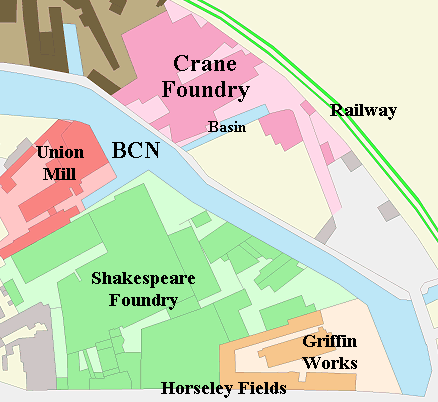
The location of the the
foundry. |
A look at the company’s 1928
catalogue reveals over 300 products including
weights, rice bowls, sad irons, ventilators, mole
traps, door knockers, and hinges.
The company moved away from
metalware and began to concentrate on the production
of castings for engineering companies.
|
| On 25th June, 1945 Josiah Parkes & Sons sold the foundry to
Qualcast for £9,200, and in 1949 the foundry was
officially called Qualcast (Wolverhampton) Limited.
The company also owned the nearby Swan Gardens Iron
Works off Swan Street. |
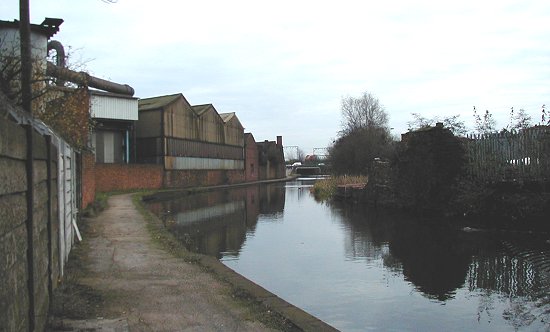
Crane Foundry and the canal in 2003.
|
Production concentrated on
light repetition work for the engineering industry.
Grey castings were produced, weighing from a few
ounces to half a hundredweight. Castings were
supplied to vehicle manufacturers, gas and electric
cooker manufacturers, hand tool makers, and
lock makers. Castings were also made for electric
motors, lawn mowers, sewing machines, typewriters,
washing machines, telephone equipment, and conveyor
rollers for the mining industry. The Swan Gardens
foundry opened in 1953 and produced larger castings
from 0.5 to 3 hundredweights for motor cars,
commercial vehicles, farm tractors, stationary
engines, electric motors, refrigerators, and
domestic water heaters.
Things started to go wrong
during the recession of the 1970s when many of the
country’s foundries closed. Qualcast was hit hard by
a series of industrial disputes and the Swan Gardens
Foundry lost a lot of orders due to the recession in
the tractor industry, which resulted in its closure on 24th June, 1972.
|
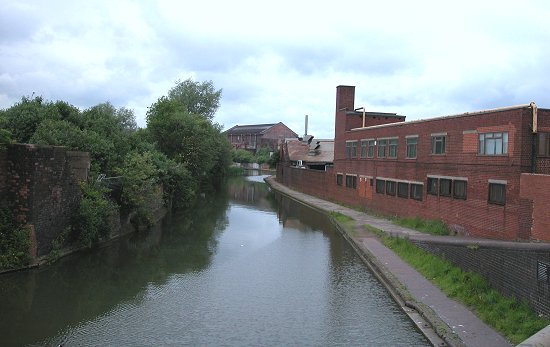
Another view of the factory in 2003.
|
Luckily the Crane Foundry
survived and began to supply castings to mainland
Europe. By 1978 the foundry employed around 600
people and produced 300 tonnes of castings per week.
Castings were made for the automotive industry, gas
cookers, multi-fuel stoves, domestic appliances, and
general engineering. As the recession continued, the
Qualcast group closed most of its factories. Crane
Foundry only survived because of a management
buy-out.
Because the foundry was
overmanned, a rationalisation programme began, but
the redundancy costs were so high that even with a
healthy order book, liquidation soon followed.
Receivers were appointed in 1985, but after another
management buy-out, and with financial backing from
Crane’s two largest customers, Stanley Tools and
Brook Motors, the company survived. It was renamed
Crane Foundry (Wolverhampton) Limited with a
workforce of just over 130.
In 1995 the company
embarked on a 2.5 million pound investment programme
to ensure that the foundry was technically and
environmentally viable. The improvements included
the installation of an electric induction
melting furnace to act as a reservoir for the
cupolas, allowing two grades of iron to be used at
the same time. |
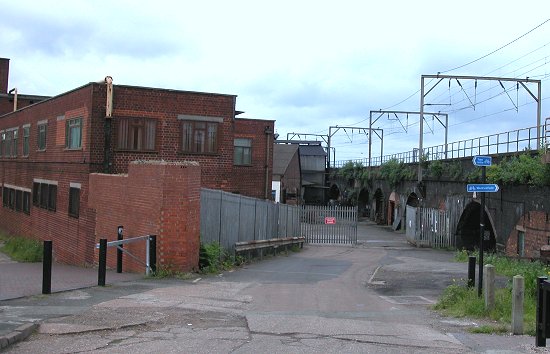
The works entrance in 2003.
|
Sadly, after all of the
investment, the company remained unprofitable, and the
workforce was reduced to 68. For a while Crane
Foundry became part of British Steel, but the
foundry went into receivership again on 21st
September, 2000. Luckily funding was found and the
company reformed itself as Crane Cast.
Things seemed
to be going well until the company’s liabilities
spiralled out of control. The rise in electricity
and gas prices, and the loss of two of the company’s
largest customers, meant that the directors had no
choice other than going into liquidation. The
factory closed in January 2006. The company and
workforce fought hard to survive, but too many
things went wrong at once. A sad end for one of
Wolverhampton’s oldest companies.
|
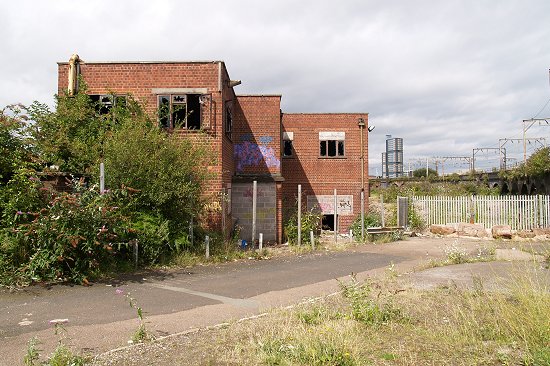
A sad sight, the derelict buildings in
October, 2009.
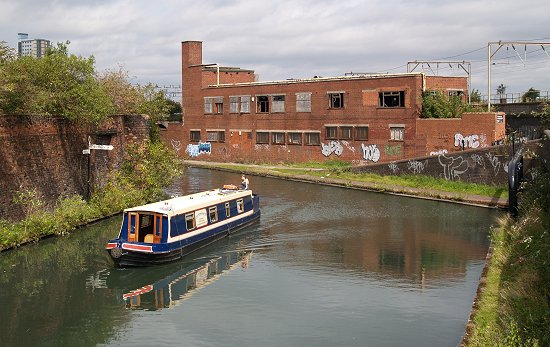
Another view of the derelict buildings in
October, 2009.
|
Read a more
detailed history of the company |
 |
 |
Return to the
previous page |
|